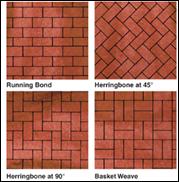Clay Brick Pavers Patterns
In many situations, a homeowner will be selecting a clay paver shape on the basis of the appearance of the paver unit. Although most clay pavers can be laid in a variety of patterns, equal consideration needs to be given to the laying pattern of the pavement so as to make it cost effective and easy for the contractor to lay down the job.
THE BASICS OF PATTERN DESIGNS
 |
Before deciding on what type of paving pattern you would like to use for your place, it would be a good idea for you to begin by getting to know the basics. A good guide to know firsthand is that laying clay pavers at a 45 degree angle to the outside of the building will bring the focus upon the area because it is a busy looking pattern and can bring about the illusion that the paved area looks smaller than it really is. If you want to make the area look larger, it would be better to apply the 90 degree laying pattern. |
Basket Weave, Stretcher Bond and Herringbone patterns are all suitable for patio and pathways.
Herringbone pattern is ideally suited for driveways and other places within the lot that is ordinarily used by cars because it can provide for the surface of the decking to accept and accommodate heavy loads such as cars and trucks. Herringbone patterns promote even load bearing and reduces the possibility for movement of the paving units and pavement system as a whole. Stretcher bond pattern should be implemented in a situation where it is anticipated that vehicles will brake heavily or accelerate consistently or make repeated turns.
Clay brick pavers are capable of being laid in a variety of different patterns to create a contrast of style and impressions upon the landscaping design.
The paving patterns are sometimes referred to as ‘bonds’.
There are three basic patterns that are based upon the assumption that most paving is installed using standard rectangular shaped clay paving block or brick.
There are other types that are applied on the basis of using irregular shaped clay pavers such as wedge shaped pavers, which are needed to form circular, curved and fanned.
The basic patterns for laying rectangular shaped clay pavers are:
- Stretcher Pattern
- Basket Weave Pattern
- Herringbone Pattern
Each of these has its own distinctive appearance and can be varied to create a slightly different look, yet it still has its own unique style.
Stretcher Bond Pattern
| This is used as a clay brick paver laying pattern. It has a side-by-side appearance and is the simplest to install. Stretcher bond can be made to appear longer or broader depending on which direction it is laid. If you want a deck or path to appear longer, then it should be laid in a length wise direction. Alternatively, if you want to bring about the impression of a wide pathway, then you could lay the clay paver in a wide direction across the deck |  |
Basket Weave Pattern
| When desiring an old English landscaping design, it would be best to make use of the basket weave pattern and is best suited to antiqued style clay pavers. Be aware that this pattern is becoming less popular nowadays. It is more suited to someone who wants a historical look and will be using second hand pavers. |  |
Herringbone Pattern
There are two basic types of herringbone patterns. One is the 45 degree and the other is 90 degree pattern. The 45 degree is establishing itself as the outdoor entertainer's favorite, such as patios and covered awnings. It is well suited with an edging featured clay paver and can appear to be loud and noticeable. TThe 90 degree herringbone pattern is more subdued in appearance and will match nicely with pre-existing paths, walkways and pool paving. As previously mentioned 45 and 90 degree herringboned patterns are recommended for heavy vehicle applications. |
 |





